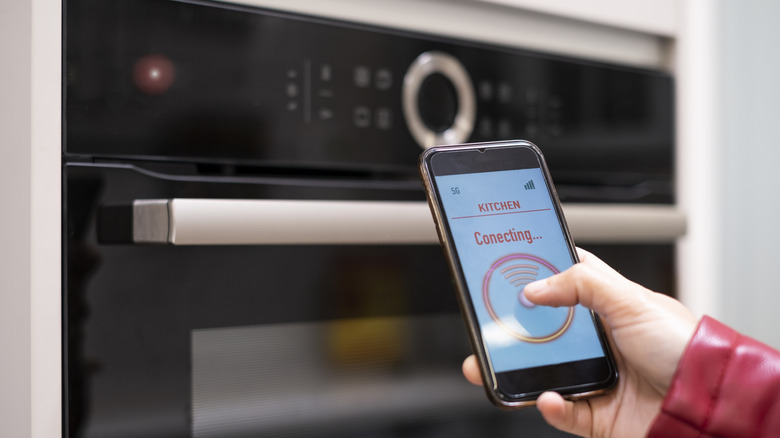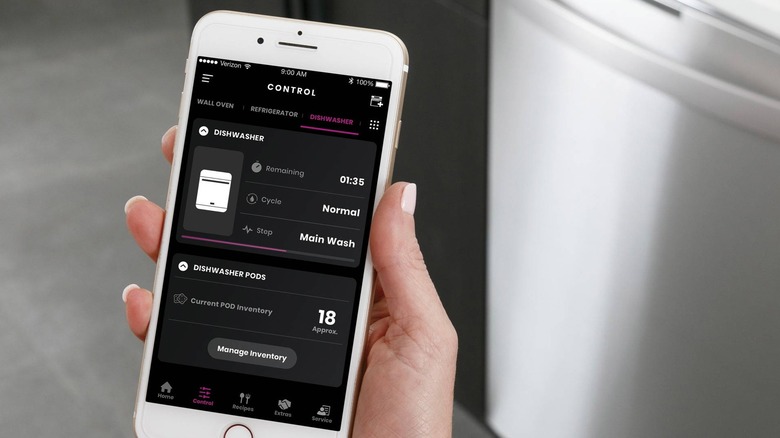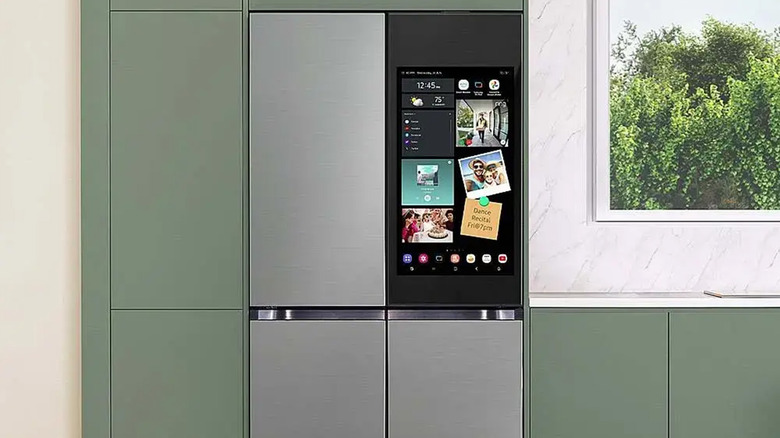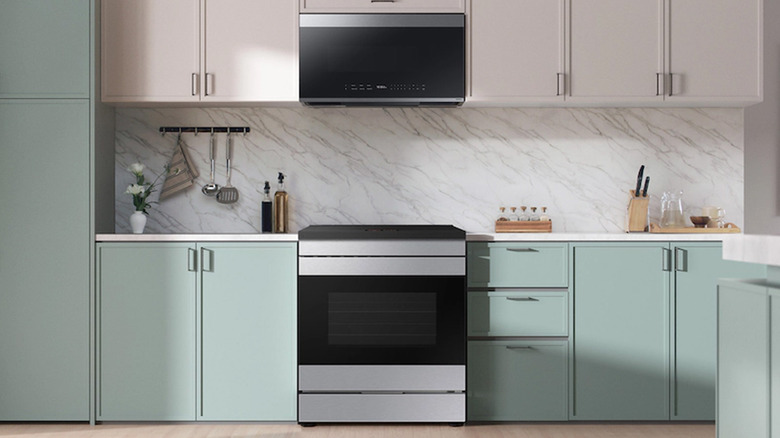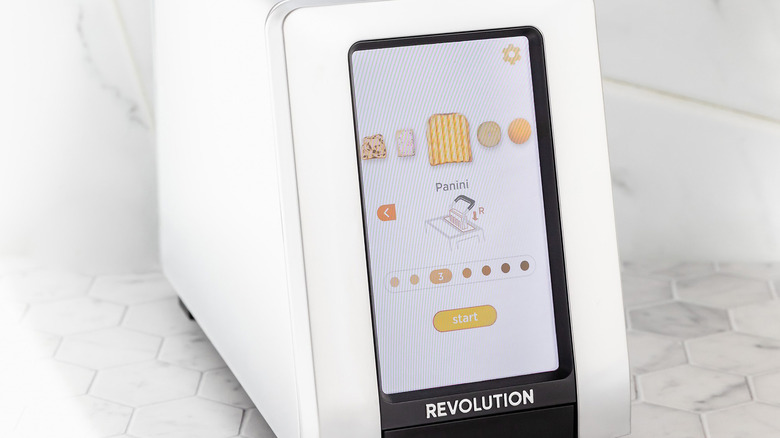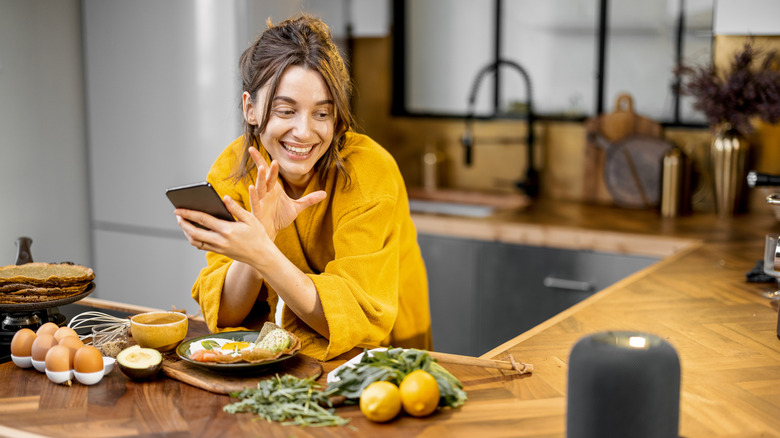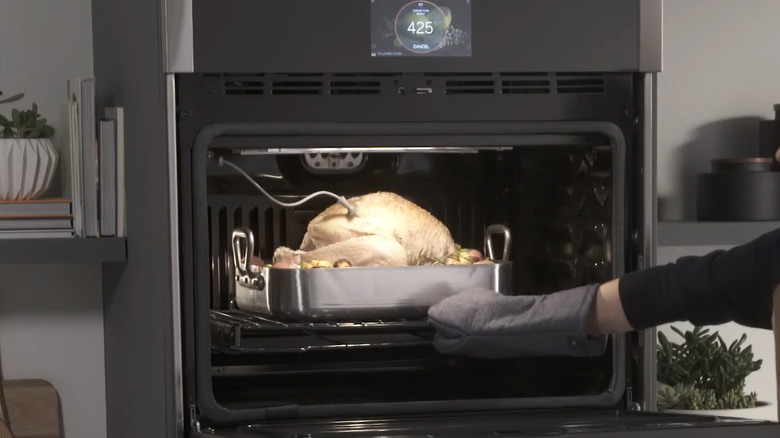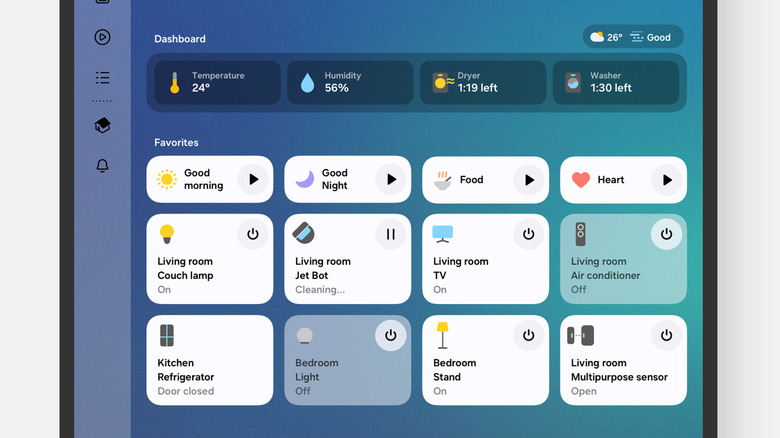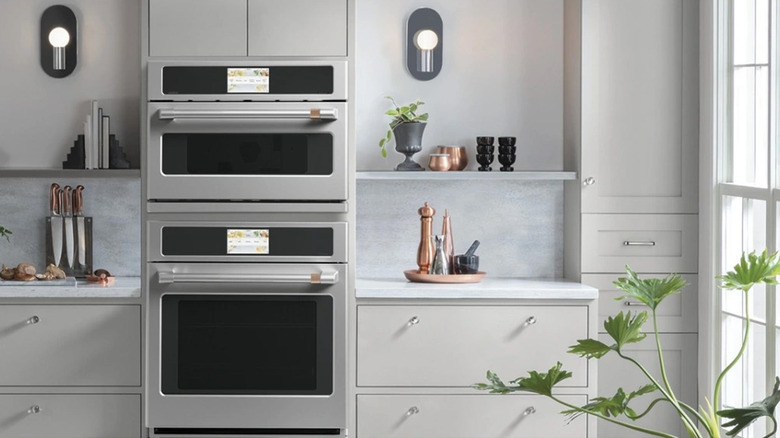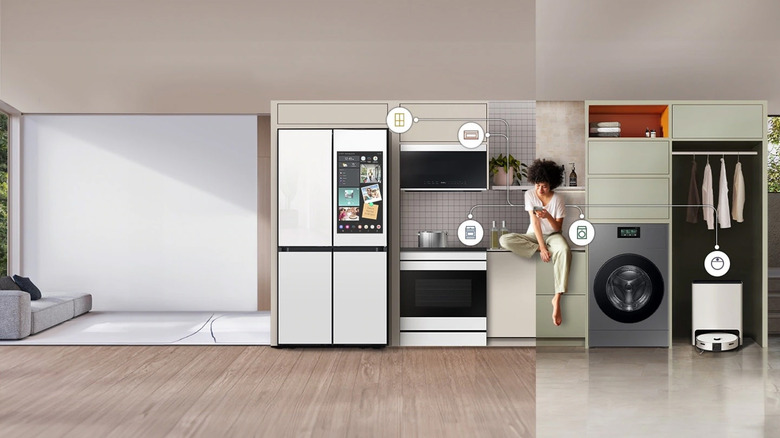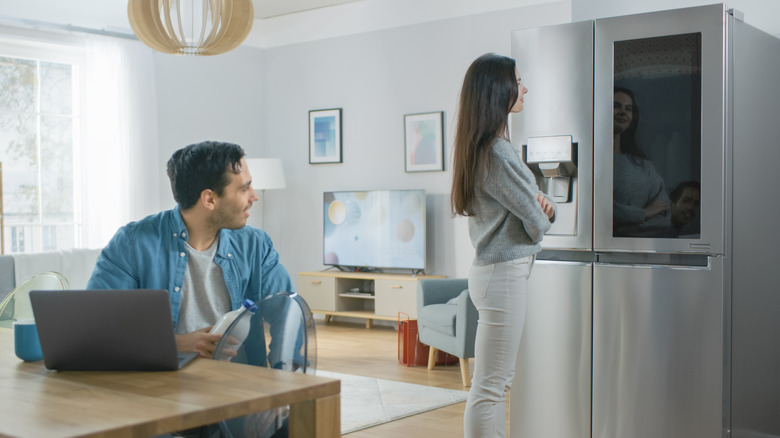The Most Useless Tech Included In Today's Kitchen Appliances
We may receive a commission on purchases made from links.
Smart home technology has arrived in a big way and it's no longer unusual to see box stores packed with kitchen appliances that offer all sorts of smart features. Many appliances come with the ability to connect to Wi-Fi, download updates, and be controlled from an app at the bare minimum. Depending on the actual appliance, other features arrive as well. There are refrigerators that can keep tabs on what's inside of it while ovens can be preheated with voice controls. Even smaller appliances like coffee makers can be set to a schedule or a routine that connects with other smart home tech.
For the most part, many of these features are pretty nice. Being able to wake up and tell Alexa, Siri, or Google Assistant to start your morning routine and have a pot of coffee brewed by the time you're done brushing your teeth is pretty sweet. As a smart oven owner, I have begun preheating the oven while on my way home from somewhere else on multiple occasions so when I get home, I can just toss the pizza in the oven without waiting 10 minutes for the oven to preheat. After all, if smart kitchen appliances were all bad, they wouldn't be so popular, and some of the features are genuinely fun or at least functional.
However, there are some features that are either useless or a waste of money, or both. These features are just there to pad the spec sheets and you can get along just fine without them. We'll start with the most egregious one we could find, which is the good old subscription.
Subscriptions (and advertisements)
A former coworker once told me that he was sick of being "subscriptioned to death." At the time I disagreed because it wasn't that bad. When I conducted research for this article, I have since come around. Kitchen appliance manufacturers have been trying to figure out how to charge you monthly for that box in your kitchen that functions perfectly without a subscription, and tech companies aren't shy about this. LG once told PCMag that "LG will innovate with a platform-based service business model that continuously generates profits, such as content and services, subscriptions and solutions, to the hardware-oriented businesses."
So far, it hasn't been met with popularity or even any modicum of success. One example is the Mill Food Recycler, a $999 recycling bin that composts your garbage into fertilizer for use in gardens and lawns. It came with a subscription service that nobody wanted, which the company ultimately dropped. The Mill's subscription had customers paying $33 per month for the bin and for proprietary boxes that you could use to ship waste that you didn't intend on using. It wasn't a great idea.
GE is trying this out with some of its appliances, specifically its dishwashers. It wants to charge customers $59 per year for service protection, discounts on further purchases, advanced notification alerts, new cycles, future features, and the ability to track things like water and energy usage. Most of those can be done without a subscription cost, including the notifications and water usage tracking. While we're on the topic of unnecessary things, Samsung's refrigerators with fancy screens now show play advertisements, which just isn't ideal.
Screens on smart fridges
Speaking of those fancy screens, your refrigerator honestly doesn't need one. They are a neat concept and can be fun in certain circumstances, and we've encountered plenty of people online who enjoy being able to stream movies or TV shows to their fridge while they cook. Others have embraced the toy-like nature of the feature. After all, being able to scribble out a note that everyone will be able to see when they pass through the kitchen is kind of nice.
The big issue with screens on fridges is that they will go out of date long before the fridge breaks down — provided that the fridge maker isn't terrible at making fridges. The average amount of time that people keep their fridge is for somewhere between 10 and 20 years depending on who you ask. Smart tech generally doesn't live that long, which presents a problem.
After all, if you bought a smartphone or tablet 10 years ago, that was 2014. That is the iPhone 6 and Samsung Galaxy Note 4 generation of devices. Google was still selling Nexus tablets back then. Most of those devices are fairly useless by today's standards and even budget-oriented devices perform better than the best devices did 10 years ago.
By the time your smart fridge crosses the rainbow bridge, the screen on the front of it will be shell of its former self and would have been for years at that point. Yes, smart fridge makers push updates, but those updates can cause issues on their own. Plus, many of those features are also available on smart displays like the Google Home Hub, which you can easily put in a kitchen. Those passthrough windows on some fridges are awesome, though.
Smart microwaves in general
There are clear use cases for having a smart oven or a smart fridge. For example, preheating your oven from your neighbor's house before you get home can be a convenience boon for many folks. Smart microwaves, on the other hand, don't really offer much of a benefit over their dumb brethren. After all, if you're popping in a bag of popcorn, all you need to hit is the popcorn button. There is no real need for app control or voice control for something like that.
In fact, looking down through the list of smart features that commonly come on kitchen appliances, none of them seem overly helpful. Microwaves are rarely used for long enough to need an alert on your smartphone but that's the one use case that seemed to make sense. In nearly all cases, it takes less time to manually input the cook time than it is to engage with your voice and while most people use their microwaves every day, it's usually only for long enough to reheat a slice of pizza or warm up a bowl of soup.
In short, there are very few use cases where having a smart microwave is worth the trouble. Some folks may enjoy things like sensor-based cooking or more automated cooking programs, but a quick Google Search can solve both of those problems without much hassle. Users have to manually load and unload the microwave so people rarely stray far from their microwaves while they're in use, making most of the other smart features redundant or unnecessary.
Also smart toasters in general
Smart toasters have the same issue as microwaves where they're used in such a specific way that having smart features doesn't feel like it's worth the upcharge for a smart toaster. This is especially true when you get to the higher end of smart toasters, which can cost hundreds of dollars. Toasters are fairly simple appliances with fewer use cases than the big dogs like ovens or microwaves, which makes per-food customization feel a little bit over the top.
That isn't to say that smart toasters have no utility. For example, Revolution R180 Connect Toaster has a few legitimately useful little tricks. For example, you can set it to toast fresh items, frozen items, or reheat cold items and the toaster will adjust its temperatures accordingly. That's pretty nice. However, that's something you could add to a dumb toaster and omit the massive screen and hundreds of dollars in upcharges for a two-space toaster.
On top of its one useful feature, it can also do things like show you the date and weather and set a timer. These are things that are best left to other devices like a kitchen-placed smart display since you can then use those features without needing your toaster. Things like quick-heating coils and multiple temperature settings are doable on a regular toaster and wouldn't cost over $300 like the top-end smart toasters. For the most part, smart toasters are just another screen in your kitchen that you ultimately don't need since most of the other smart displays present in your kitchen — including your smartphone — can do the same things.
Voice control on virtually anything
Voice controls are useful in a variety of scenarios. Asking your smart speaker to play music or asking a question is super useful. On my Google Home Hub, I've asked for recipe ideas and to turn off lights around my home. When it comes to kitchen appliances, however, voice controls are a little less useful and varied. For the most part, most appliances let you use voice controls to turn them on or off or adjust a specific setting.
Here's the thing, it doesn't really save any time. It takes less time to dial in my oven temperature than it does to ask my oven to do it. In most cases while cooking, you're right next to the stove anyway so you can adjust the settings there. Microwaves have the same detriment. People generally turn it on right after putting something in, so there's really no need to ask. On the higher end of kitchen tech, appliance makers have experimented with things like a fridge that opens when you ask it. While very cool, the same logic applies. You'll be right next to the fridge anyway — you might as well just open it yourself.
There are exceptions to the rule. Being able to turn on your coffee maker from your bedroom by asking a smart speaker to start a morning routine is quite handy. However, by and large, most kitchen appliances require the user to engage with the appliance while using it, making voice controls redundant as the user is almost always standing right there to do it themselves.
Built-in meat thermometers
Built-in meat thermometers aren't necessarily a smart feature as some ovens had this tech before smart appliances existed. However, it is quickly becoming a common feature in smart ovens. The feature isn't half bad on its own. Having a temperature probe attached to the oven saves you the need to have one in the kitchen and it's good for longer cooks like Thanksgiving turkeys or Christmas roasts. When it comes to the smart part of it, though, appliance makers could be doing better.
In general, built-in temperature probes are pretty simple, even on smart appliances. Typically, you'll get an alarm on the oven when your temperature is reached, and the oven will turn itself off once that happens. That's not a bad start, especially being able to turn off the oven so your food doesn't burn if you happen to forget or be out of earshot for the alarm. It could even save you from having to put out a fire.
The thing is, when it comes to smarts, there are other, potentially better options. Bluetooth temperature probes have come a long way over the years and grants you many of the same benefits while not tying you down to the type of oven you buy. A good smart meat thermometer will alert your phone when the meat is done, can pair with multiple probes at once for when you cook multiple things, and it has the benefit of not being attached to the oven so you can use it on the grill or smoker as well. In this case, it's better to get the standalone smart tech instead of the built-in smart tech.
App control on some appliances
App control for kitchen appliances has the same detriments as voice control. In most cases, the user is actively using the kitchen appliance so there's no real need to pull out a smartphone, open an app, and perform a task that you can do while you're standing right there next to it. After all, who's really loading their dishwasher, walking to another room, and then starting it with the app? It doesn't make much sense.
Of course, like all the features on this list there are some exceptions. Preheating an oven as you're leaving work is arguably the best one. Some appliances let you check your water or power usage from the app as well, which can be very helpful in saving money. These use cases are quite helpful when they apply to you. For the most part, though, people have to be within arm's reach to prepare the appliance for use anyway, so it often makes more sense to just control while you're there. Dishwashers, fridges, microwaves, and toasters are all examples of appliances that probably don't need an app unless you want to check energy usage or play around with settings.
Much like voice control, app control feels like something makers had to add because other smart home tech has it. It's still faster to use an app to turn off all your lights instead of doing it manually, after all. Kitchens are just unique that way in that most of the time, you're actively using the appliance so there's no need to control it from an app.
Downloadable routines for various appliances
This one might be a bit controversial because how useful it is can be deeply subjective. Many smart appliances come with various programs to run different things. Examples include the popcorn button on the microwave or the bagel setting on a toaster. Some smart appliance makers have created a system where you can download additional routines to give you more options when cooking food or doing other things.
Such ideas are hit and miss. LG does this with their washers and people quite enjoy having different wash settings if the basic ones aren't quite what they're looking for. On the other hand, nearly all of these downloadable routines can be recreated on the appliance itself. For example, LG washers have a downloadable Allergiene cycle that claims to be good for allergens. However, it's just a steam cycle tossed into a regular wash cycle, using the steam to kill dust mites. This applies to everything from smart microwaves to smart stoves that have special routines for different foods. You can recreate them all yourself.
The other dark side of downloadable cycles and features is that some makers are charging a subscription for it. GE does this with its dishwashers as we mentioned above. One of the benefits of its $59 per year subscription is the ability to download new cycles. Much like LG's washers, these are just various tweaks on existing settings, which means that user can potentially recreate those cycles for free. Also, it's a dishwasher, and there are only so many settings to tweak anyway.
AI-powered features
AI is making its way into everything and that includes the kitchen. This is still rather new, so there aren't a ton of examples yet. There are some grills, some other appliances, and a lineup of Samsung Bespoke appliances that have it at the very least. Given how AI is in its early days, there are very few use cases where AI could be useful in the kitchen and, much like voice and app control, in most cases it's simply faster and easier to do it yourself.
For the most part, AI features are things that already exists but are now powered by AI. For instance, Samsung's Bespoke AI fridge uses AI to identify the things in your fridge so that you can see what's in there without opening the door. Meanwhile, the Samsung Bespoke stove will send personalized recipe recommendations, stream recipe videos, and run apps. These things look cool on a spec sheet but is a 7-inch stove-top screen the best place to watch recipe videos while actively trying to cook? Such things are best left to smartphones, tablets, or smart displays.
The Brisk It Origin 580 AI Powered Grill is perhaps the best example of AI tech in a cooking appliance. You can talk to it as it has a chatbot built-in. It'll also adjust temperatures automatically and do a host of other things. However, the reality is it doesn't save the user much time since they still have to the lion's share of the work. There are better ways to spend money on quality appliances and chatbots aren't it.
Wi-Fi enabled appliances make security worse
Being connected to the Internet has its share of risks in terms of security. After all, your smart appliance can use the Internet and that means that the Internet can get to your kitchen appliance. This is a double-edged sword as some features are genuinely worthy of use. That use comes with a cost, though, and that's security. There are already stories out there of people having their fridges hacked and tech pundits believe that a worldwide appliance botnet is all but inevitable.
There are ways to combat this like having strong home Wi-Fi security and making sure your appliances stay up to date with the latest updates. Both of those tasks are fairly difficult, especially for those who aren't so tech savvy. Plus, as mentioned earlier, software updates can come with their own problems that are difficult to troubleshoot on an appliance with doors and burners but not a keyboard or mouse. Even if your appliance works perfectly, eventually the appliance maker will stop supporting it and we've already talked about how tech generally doesn't last as long as appliances are supposed to.
In general, Wi-Fi connectivity can be genuinely useful but it's up to you to decide if it's worth the potential headaches. My wife loves that the washer and dryer send alerts when they're done so she never has to set a timer. However, our washer and dryer might be used to DDoS attack someone someday. It's a double-edged sword.
